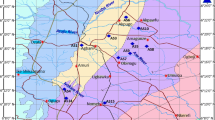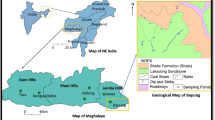Abstract
Organic geochemical analysis, palynology, and PetroMod software for the organic matters of subsurface Tithonian to Valanginian Sulaiy formation of six wells in Basrah Region, South Iraq showed evidences for hydrocarbon generation potential. These analyses include quantitative studies such as pyrolysis, fluorescence spectroscopy, and total organic carbon (TOC), while the qualitative studies are the textural microscopy used in evaluating amorphous organic matter for palynofacies analysis leading to hydrocarbon assessments. High TOC content of up to 7.3 wt.%, kerogen type II of mesoliptinic type with hydrogen index of up to 466 mg HC/g TOC, and mature organic matter along with dysoxic–anoxic environment and stratigraphic framework have rated the succession as a source rock for oil with ordinate gas, not only in Iraq but also in neighboring Kuwait and Saudi Arabia. This case study is also inferred for hydrocarbon generation and expulsion by PetroMod software which confirmed the source potential.
الخلاصة
لقد اظهرت تحليلات الجيوكيمياء العضوية والبالينولوجية والبرمجة الحاسوبية للمواد العضوية في تكوين السلي الممتد عمراً بين التيثوني والفالانجيني لستة آبار في محافظة البصرة في جنوب العراق أدلة لقدرة نشوء الهيدروكاربونات. شملت هذه التحليلات دراسات كمية مثل البيروليسيس والطيف الفلورسيني واجمالي المواد العضوية، بينما شملت الدراسات النوعية استعمال التراكيب المجهرية في تقييم المواد العضوية العديمة الشكل التركيبي ضمن السحنات البالينولوجية المؤدية الى تحديد الهيدروكاربونات. لقد تم اعتبار التعاقبات الطبقية لتكوين السلي صخوراً مصدرية للنفط وبعضاً من الغاز اعتماداً على الكمية العالية لاجمالي المواد العضوية حتى 3 ،7% وزناً وكيروجين النوع الثاني الغني بالليبيد ومؤشر الهيدروجين الذي يصل الى 466 ملغم هيدروكاربون لكل غرام اجمالي المادة العضوية ومواداً عضوية ناضجة وبيئة انعدام التهوية والهيكلية الطبقية، ليس في العراق فقط ولكن في الدول المجاورة الكويت والمملكة العربية السعودية. لقد تم التأكد من نشوء الهيدروكاربونات واندفاعها من تكوين السلي لمناطق التجميع بواسطة البرنامج الحاسوبي البيترومود.






Similar content being viewed by others
References
Beydhoun ZR (1991) Arabian plate hydrocarbon geology and potential, a plate tectonic approach. Am Assoc Pet Geol Stud Geol 33:70
Al-Ameri TK, Al-Musawi FA, Batten DJ (1999) Palynofacies and source potential for hydrocarbon, uppermost Jurassic-basal Cretaceous in Sulaiy formation, southern Iraq. Cretac Res 20:359–363
Al-Sharhan AS, Nairn AEM (1997) Sedimentary basins and petroleum geology. Elsevier, Holland, p 943
Batten DJ (1996) Palynofacies and petroleum potential. In: Jansonius J, McGregore DC (eds) Palynology: Principles and Application, vol 3. American Association of Stratigraphic Palynologists Foundation, Dallas, pp 1065–1084
van Bellen RC, Dunnington HV, Wetzel R, Morton DM (1959) Lexique stratigraphquie international, vol III, Asie, Fasicule 10a Iraq. Centre National de la Recherche Scientifique, Paris 333 pp
Brooks J (1981) Organic maturation studies and fossil fuel exploration. Academic, London, p 360
Bujack JP, Bars MS, Williams GL (1977) Offshore east Canadas organic types and colors and hydrocarbon potential. Oil Gas J 75:96–100
Claypool G, Peters K, Wildharber J (1994) Exploration Geochemistry Reference Guide. MEPTEC, Medicine Park Project BK4WAA10, 8 pp, 7 tables, and 6 figures
Dumke U, Teschner M (1987) Application of fluorescence spectroscopy to geochemical correlation problems. Advances in Organic Geochemistry 13:1067–1072
Durand B (1980) Sedimentary organic matter and Kerogen. In: Durand B (ed) Kerogen: insoluble organic matter from sedimentary rocks. Edition Technip, Paris, p 450
Hunt JM (1996) Petroleum geochemistry and geology, second edition. Freeman, New York, p 743
Lewan MD, Ruble TE (2002) Comparison of petroleum generation kinetic by isothermal kinetic and non isothermal open systempyrolysis. Org Geochem 33:1457–1475
Peters KE (1986) Guidelines for evaluating petroleum source rock using programmed pyrolysis. Am Assoc Pet Geol Bull 70:318–329
Pitman JK, Stenshouer D, Lewan MD (2004) Petroleum generation and migration in the Mesopotamian Basin and Zagrous Fold Belt of Iraq: results from a basin-modeling study. Geo Arabia 9(4):41–72
Pollastro RM, Karshbaum AS, Viger RG (1999) Map showing geology, oil and gas fields, and geologic provinces of the Arabian Peninsula. US Geological Survey, Washington, DC Open File Report 97-470B Version 2
Rahman M, Kinghorn RRF (1995) A practical classification of kerogen related to hydrocarbon generation. J Pet Geol 18:91–102
Rulkotter JP (1987) Geochemistry, Organic. Encycl Phys Sci Technol 6:53–77
Sharland PR, Archer R, Cassey DM, Davies RB, Hall SH, Heward AP, Horbery AD, Simmons MD (2001) Arabian Plate Sequence Stratigraphy. Gulf PetroLink, Bahrain 371 pp
Staplin FL (1969) Sedimentary organic matter, organic metamorphism, and oil and gas occurrences. Bulletin of Canadian Petroleum Geology 17:47–66
Thompson CL, Dembicki H Jr (1986) Optical characteristics of amorphous kerogens and the hydrocarbon-generation potential of source rocks. Int J Coal Geol 6:229–249
Tissot B, Welte DW (1984) Petroleum formation and occurrence, 2nd ed. Springer, Heidelberg, p 480
Tyson RV (1995) Sedimentary Organic Matters, Organic facies and palynofacies. Chapman & Hall, London, p 615
Whelan JK, Thompson-Rizer CL (1993) Chemical methods for assessing kerogen and protokerogen types and maturity. In: Engel Michael H, Macko Stephen A (eds) Organic Geochemistry. Plenum, New York, pp 289–353
Author information
Authors and Affiliations
Corresponding author
Rights and permissions
About this article
Cite this article
Al-Ameri, T.K., Al-Musawi, F.A. Hydrocarbon generation potential of the uppermost Jurassic—basal Cretaceous Sulaiy formation, South Iraq. Arab J Geosci 4, 53–58 (2011). https://doi.org/10.1007/s12517-009-0064-y
Received:
Accepted:
Published:
Issue Date:
DOI: https://doi.org/10.1007/s12517-009-0064-y




